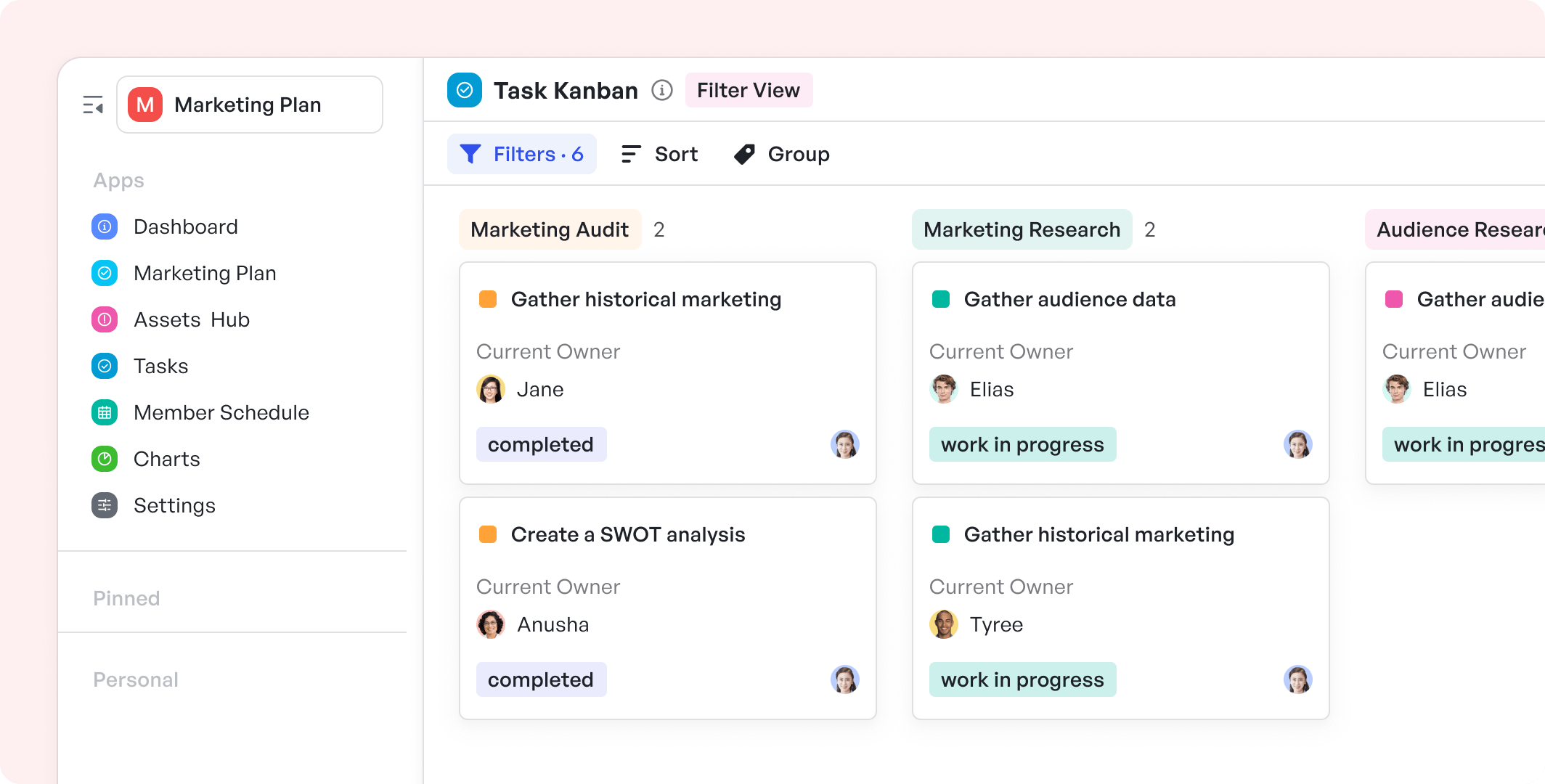How to Implement Kanban in Marketing

Kanban has proven itself to be an effective tool in project management, particularly for its flexibility and adaptability to different industries. While traditionally associated with manufacturing, Kanban is increasingly being used in marketing to streamline workflows, improve communication, and enhance productivity.
In this article, we’ll explore how Kanban can be implemented in marketing teams, focusing on visualizing workflows, managing tasks, and optimizing processes. Let’s dive into the core principles of Kanban, how to set up your board, and how it can be tailored to meet the unique needs of marketing.
Understanding Kanban Principles
Kanban is based on a few fundamental principles that make it a highly adaptable and efficient system for managing work. It’s an approach that can help marketing teams stay organized, reduce bottlenecks, and ensure steady progress.
Visualizing Workflow
The first and most critical principle of Kanban is the visualization of workflow. By displaying all tasks on a board, team members can easily see which tasks are being worked on, which are awaiting attention, and which are completed. This visualization enhances transparency, improves team communication, and helps identify any potential bottlenecks in the process.
For marketing teams, visualizing tasks such as campaign creation, content production, or social media scheduling allows for better planning and tracking.
 Workflows in Meegle
Workflows in MeegleTools like Meegle can help create customized Kanban boards that visualize all stages of marketing activities, from concept to execution, ensuring the team is aligned and focused on the right tasks at the right time.
Limiting Work-In-Progress (WIP)
Limiting WIP is another key aspect of Kanban. This principle helps prevent teams from taking on too many tasks at once, which can lead to burnout, inefficiencies, and missed deadlines. In a marketing context, setting WIP limits ensures that teams are only working on a manageable number of tasks at any given time.
By using tools like Meegle, marketing teams can set WIP limits for each task or campaign stage, ensuring that they focus on quality over quantity and complete each task before taking on new ones.
Managing Flow Effectively
Managing flow refers to the movement of tasks through the various stages of the Kanban board. A well-managed flow ensures that tasks are completed efficiently and in a timely manner. It helps teams avoid unnecessary delays and keep projects on track.
Kanban’s approach to managing flow is especially beneficial in marketing where campaigns often require coordination between different teams—designers, copywriters, strategists, and analysts. Meegle’s customizable workflows allow teams to track progress, manage dependencies, and adjust as necessary to maintain smooth, consistent flow across tasks.
Making Policies Explicit
Clear and explicit policies help ensure that everyone understands the rules for how tasks move through the system. For marketing teams, this means setting clear guidelines for task assignments, deadlines, and priorities.
Meegle allows teams to define these policies in a simple, visual format, ensuring that everyone is on the same page and knows how to handle each task as it progresses through the workflow.
Using Feedback Loops
Continuous feedback is crucial in Kanban. Regular feedback loops allow teams to assess their work and make adjustments as necessary. For marketing teams, this could mean reviewing the progress of a campaign and making tweaks based on performance data or team insights.
Meegle provides real-time reporting and feedback features that enable marketing teams to track performance, gain insights, and iterate their campaigns for better results.
Setting Up Your Kanban Board
The Basics of a Kanban Board
A Kanban board is a visual tool used to track tasks and monitor progress. Typically, it consists of several columns representing different stages of work—such as “To Do,” “In Progress,” and “Completed.” Each task is represented by a card that moves across the board as it progresses through these stages.
Customizing for Marketing Needs
The beauty of Kanban lies in its flexibility. Marketing teams can easily customize their Kanban boards to reflect their specific workflows. For instance, a marketing Kanban board might include columns like “Planning,” “Content Creation,” “Design,” “Approval,” and “Launch.”
Meegle offers highly customizable Kanban boards tailored to different marketing activities, helping teams visualize every stage of their campaigns. These customizable views make it easier for teams to prioritize tasks, set deadlines, and ensure alignment across different roles.
Examples of Marketing-Specific Boards
In the world of marketing, there are various types of boards you can set up to manage different aspects of a campaign. Here are a few examples of marketing-specific boards:
- Content Marketing Board: A Kanban board to manage content creation, approval, and distribution. Columns might include “Topic Ideas,” “In Progress,” “Editing,” and “Published.”
- Demand Generation Process: A Kanban board for managing lead generation tasks, from “Lead Capture” to “Nurturing” to “Conversion.”
- PR & Social Media Campaigns: A board to manage social media posts, press releases, and outreach campaigns, with columns like “Draft,” “Review,” “Scheduled,” and “Published.”
Meegle’s Kanban boards allow you to set up these boards quickly, assigning tasks to team members and ensuring that work flows efficiently.
Breaking Down Marketing Tasks
Prioritizing Tasks Effectively
One of the challenges marketing teams often face is task prioritization. With Kanban, you can prioritize tasks by simply dragging them to the top of your board. This makes it easier for teams to focus on the most important tasks and avoid getting bogged down in low-priority work.
Meegle’s task prioritization features enable marketing teams to easily reorder tasks, ensuring that they’re always focused on what matters most. This flexibility helps marketing teams stay agile and responsive to changes in their environment.
Tracking Progress and Adjusting
Kanban’s real-time tracking allows marketing teams to monitor the status of each task and make adjustments as needed. If a particular task is taking longer than expected, teams can assess why and adjust their approach.
With Meegle’s real-time updates and visual tracking, teams can easily monitor the progress of each task and ensure that they stay on schedule.
Tailoring Kanban to Different Marketing Areas
Content Marketing Board Setup
For content marketing, a Kanban board can be used to manage everything from content ideation to publishing. Teams can create cards for each piece of content, moving them through stages such as “Research,” “Writing,” “Editing,” and “Publishing.”
 Marketing plan template in Meegle
Marketing plan template in MeegleMeegle’s flexible workflows and templates allow content marketing teams to visualize every stage of content production, ensuring a smoother, more organized process.
Demand Generation Process
Kanban can also be used to streamline demand generation processes. With columns for “Lead Generation,” “Lead Nurturing,” and “Lead Conversion,” teams can track leads, identify bottlenecks, and ensure a consistent flow of new opportunities.
Meegle’s integration capabilities allow marketing teams to sync their Kanban boards with customer relationship management (CRM) systems, providing a seamless workflow from lead generation to conversion.
Also see: Email Marketing Template and E-Commerce Business Plan Template
PR & Social Media Campaigns
Social media and PR teams can use Kanban to manage campaigns from initial strategy to final execution. By breaking the process down into manageable tasks, teams can ensure that deadlines are met and the campaign stays on track.
Meegle’s real-time communication features help social media and PR teams collaborate more effectively, ensuring a smooth flow of tasks and a cohesive strategy.
Implementing Work-In-Progress Limits
Setting Realistic WIP Limits
Work-in-progress limits ensure that no team is overwhelmed with too many tasks at once. By setting realistic limits, marketing teams can focus on completing tasks before starting new ones.
Meegle helps teams set WIP limits for each stage of the process, ensuring that work doesn’t pile up and that team members can focus on completing tasks efficiently.
Utilizing Swimlanes for Organization
Swimlanes allow teams to organize tasks into different categories, such as priority, department, or team member. This helps to keep the board organized and ensures that no tasks fall through the cracks.
Meegle’s customizable swimlane feature allows marketing teams to organize tasks by any criteria they choose, making it easier to track progress and manage multiple marketing initiatives at once.
Integrating Tools for Enhanced Kanban
Useful Kanban tools include Meegle, Jira, Trello, monday.com, and Asana, which offer features like task tracking, collaboration, and reporting. These tools, when integrated with Meegle, help marketing teams stay on top of their tasks and collaborate more effectively.
Encouraging Team Feedback
Kanban emphasizes continuous improvement, and team feedback is a key part of this process. Encouraging marketing teams to provide feedback on workflows, task assignments, and overall performance helps identify areas for improvement.
Meegle fosters collaboration and feedback by providing easy-to-use communication tools, allowing teams to engage in productive discussions and refine their processes.
Fostering Experimental Evolution
Kanban encourages teams to experiment and evolve. By trying different approaches, marketing teams can continuously refine their processes and find what works best for them.
Meegle’s customizable workflows enable marketing teams to experiment with different methods, allowing them to adapt to changing requirements and optimize their workflows for maximum efficiency.
Ensuring Sustainability in Marketing Processes
Uncluttering Campaigns
Kanban helps marketing teams keep their workflows uncluttered by visualizing tasks and limiting WIP. This ensures that only necessary tasks are being worked on at any given time, reducing clutter and increasing focus.
Focusing on Value Delivery
The ultimate goal of Kanban is to focus on delivering value. For marketing teams, this means prioritizing tasks that have the greatest impact on campaign success and customer satisfaction.
Meegle’s visualized dashboards help teams track the value of each task, ensuring that they stay focused on the work that will drive the most significant results.
Optimize Your Marketing Workflow with Meegle
Implementing Kanban in marketing can help streamline your processes, improve collaboration, and drive better results. With Meegle, you can visualize your workflow, set realistic WIP limits, and track progress in real-time, ensuring that your team works more efficiently and delivers greater value.
Ready to improve your marketing processes?
Try Meegle’s free version today and start optimizing your team’s workflow!
The world’s #1 visualized project management tool
Powered by the next gen visual workflow engineRead More
Check All BlogsStart creating impactful work today



